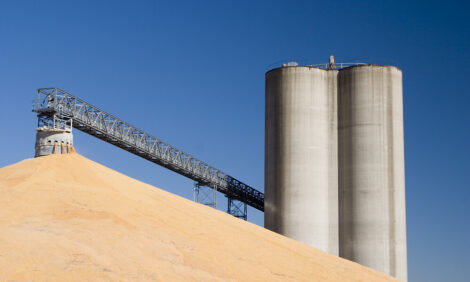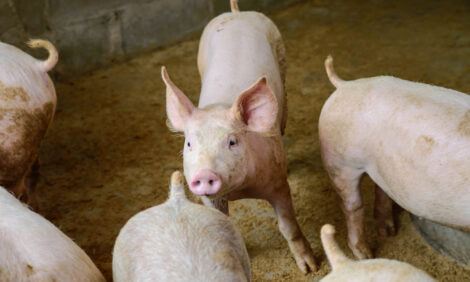



AHVLA: Gastric Ulcers with Fatal Haemorrhage
UK - Gastric ulcers with fatal haemorrhage in farrowing sows were observed in the latest AHVLA Scanning Surveillance Report for April 2012.Alimentary Disease
Salmonellosis following rejection of diet
Salmonellosis was diagnosed in six-week-old piglets by Sutton Bonington. Ten days after weaning, the pigs were introduced to a new weaner diet. The pigs became inappetant, refusing to eat the diet and developed widespread lethargy and weight loss with watery diarrhoea in a few cases and five deaths. Upon replacement of the diet, the pigs showed a ravenous appetite. Gross findings included severe diphtheritic enterocolitis, cavity effusions and generalized oedema and Salmonella Typhimurium was isolated. It was postulated that the diet rejection led to secondary salmonellosis. Further investigation revealed accidental contamination of the feed with lime explaining the pigs’ refusal of the diet.
Deaths due to haemorrhage from gastric ulcers in lactating sows
Three second-parity lactating sows died suddenly over a three-day period on an outdoor weaner-producer unit. No signs were seen prior to death and the remaining sows in the batch appeared well. One examined on farm by the attending veterinary surgeon had gastric ulceration and fatal haemorrhage. One dead sow was submitted which was markedly anaemic, also due to severe haemorrhage into the stomach from the ulcerated pars oesophagea. No underlying viral infection was detected at the time of submission and nothing about the management or feeding of these lactating sows in the individual paddocks was evident to explain the gastric ulceration. It was recommended that infectious, management or environmental factors interrupting normal feeding or causing stress during gestation be examined. If the ulcers developed during the dry period, the demands of peak lactation may have been too much for the sows to tolerate the anaemia. There was significant sandy sediment in the stomach; however, this is not an uncommon feature in outdoor sows and seems unlikely to explain the ulceration and haemorrhage. This unit has had similar ‘outbreaks’ of gastric ulceration in sows in past years and investigations continue.
Tiamulin-resistant swine dysentery diagnosed
Brachyspira hyodysenteriae was identified in 15-week-old pigs submitted to Thirsk with diarrhoea and wasting. The large intestines were dilated with reddened mucosae and prominent lymphoid nodules. Minimum inhibitory concentration (MIC) testing revealed the isolate to be resistant to tiamulin with a value of 32 ?g/ml tiamulin hydrogenfumarate. As a reference, the MIC breakpoint for tiamulin against Brachyspira hyodysenteriae is considered to be >4 ?g/ml by the agar dilution method. The development of resistance of Brachyspira hyodysenteriae to antimicrobials commonly used in the control of swine dysentery is a recognized risk, particularly in situations where medication is used long-term. Control of swine dysentery using alternative interventions (all-in, all-out management systems; cleaning and disinfection; and partial and total depopulation leading to eradication) is vital to prevent the development of wider antimicrobial resistance.
Respiratory Disease
Swine influenza detected on multiple occasions on continuous unit
A continuous single-source indoor nursery-finisher reported an ongoing problem of a dry cough amongst approximately 20 per cent of piglets with swollen joints also being seen within a week of entry to the unit. Swine influenza infection had been diagnosed in past batches. To determine whether infection was entering from the breeding unit, two live pigs were submitted from a batch of weaners as they arrived on farm. There was cranioventral consolidation of middle lung lobes in one of the pigs and pandemic H1N1 2009 virus was detected in this pig by PCR. Interestingly, the same strain was detected on both the breeding and nursery-finisher units in mid and late 2010. It is possible that there has been continual circulation on the units due to the constant availability of susceptible young pigs, with farrowing and weaning occurring weekly. Swine influenza vaccination of sows is being considered.
Concurrent swine influenza and likely Glässer’s disease in growers
Seventy of 600 seven-week-old pigs on an indoor all-in, all-out nursery finisher were affected with coughing, some scour and weight loss with deaths of both good and poor pigs. Two to four pigs had been lost each day over the ten days prior to submission and there was a poor response to antimicrobial treatment. Three seven-week-old pigs were submitted, all three of which had a fibrinous polyserositis suggestive of Glässer’s disease, although Haemophilus parasuis was not isolated. Concurrent swine influenza infection was detected by PCR, together with Streptococcus suis type 2 from the lung of one pig. The presence of swine influenza may explain the poor response of the respiratory disease to antimicrobial treatment.
Lungworm diagnosed as part of mixed respiratory disease outdoors
Pneumonia due to lungworm (Metastrongylus species) was detected in two submissions from outdoor units. The intermediate host for this lungworm is the earthworm, to which outdoor pigs have greater access. Earthworms, and the lungworm larvae within them, can survive for more than five years making carry-over of lungworm infection likely on land which is re-used for pigs. In the first submission, respiratory disease due to Glässer’s and porcine circovirus-2-associated disease (PCVAD) was diagnosed in 13-week-old pigs submitted from an outdoor rearing site. In the four days prior to submission, 20 deaths had occurred in various tents with 40 of 2,500 pigs showing respiratory disease, mainly presenting as laboured breathing and a small amount of coughing with mortality. The pigs were vaccinated for Mycoplasma hyopneumoniae and porcine respiratory and reproductive syndrome (PRRS) but not PCV-2. A fibrinous polyserositis was present from which Haemophilus parasuis was isolated and histopathology with immunohistochemistry on lungs and lymph nodes confirmed PCVAD. Interestingly, one pig had lungworm with numerous worms present in smaller bronchi. It had been thought that these pigs were the progeny of sows vaccinated for PCV-2; however, further investigation indicated that this was not the case and PCV-2 vaccination of weaners was initiated together with anthelmintic treatment for the lungworm infestation.
In the second, respiratory disease and wasting in successive batches of outdoor weaners from about two weeks after arrival from outdoor breeding units was investigated by submission of three pigs of different ages. Pigs were described as being bright, but mortality had increased from 3 to 5 per cent. Pigs were vaccinated for PRRS and Mycoplasma hyopneumoniae at weaning. Findings differed in each of the pigs; the five-week-old pig was in poor body condition with a necrotising pneumonia and abscesses from which Streptococcus suis type 1 was isolated. This pig also had candidiasis of the oesophagus, likely to be due to a combination of debility and gastric reflux due to the gastric ulceration which was present. In the seven-week-old pig, Glässer’s disease was confirmed by isolation of Haemophilus parasuis from fibrinous polyserositis lesions. In the third pig, which was 13-weeks-old, many lungworms were visible in smaller airways and histopathology confirmed a severe verminous pneumonia. Interestingly, the pigs had been on the land for a maximum of 18 months and the land had never been used for pigs prior to this unit establishing and had been a gravel pit. Pigs are wormed on entry, with successive batches going onto the same land. Investigations continue to try and determine whether lungworm infection was seeded onto the unit in pigs from one of the breeding units.
Concurrent PCVAD and PRRS in finishers with poor growth
Three 15-week-old pigs were submitted from an indoor breeder-finisher unit to investigate illthrift and unevenness in growing pigs, with finishers taking four to six weeks extra to reach slaughter weight over the last four months. Of the 400 in the batch, approximately 10 per cent were affected with three requiring culling. Pigs were vaccinated for Mycoplasma hyopneumoniae and were the progeny of PCV2-vaccinated sows. One of the three pigs had a severe pneumonia and both had enlarged pale lymph nodes suggesting possible PCVAD, which was confirmed by histopathology, together with Pasteurella multocida infection in the lung. The pig with pneumonia also tested positive for PRRS virus by PCR and immunohistochemistry confirmed direct involvement of both PRRS and PCV2 in the pneumonia.
Systemic and Miscellaneous Diseases
Rodenticide exposure in negative notifiable disease investigation in pet pig

One of two seven-month-old Kune Kune pigs on a smallholding died following clinical signs over the previous 10 days and was submitted to Bury St Edmunds. Clinical signs began with frank blood in the faeces and a few days later blood was noted in the urine. Approximately 10 days later the pig was lethargic, anorexic and died. The pig was reported to have been fed kitchen waste and the surviving pig was reported as pyrexic and dull. Gross findings were suggestive of a coagulopathy/haemorrhagic diathesis and included haemorrhages (see Figure 1) into mucosae, skeletal muscle, omentum, intestinal mucosa and serosa, myocardium, lymph nodes and spleen with blood clots in the renal pelvis and ecchymotic haemorrhages in the bladder. The farm was using difenacoum and anticoagulant toxicity was a potential cause of clinical signs. Due to the overall history the case was reported as suspect swine fever; however this was negated following a Veterinary Officer farm visit which determined that the surviving pig was clinically normal and there may have been greater access to rodenticide (difenacoum) than initially reported, in addition to the consumption of poisoned rats. The case was subsequently investigated under the Wildlife Incident Investigation Scheme where it was confirmed that three weeks prior to death the pig had accessed a bait box containing difenacoum. Advice was given regarding correct use of rodenticides and prompt disposal of dead rodents. A liver assay indicated the presence of difenacoum. It is uncertain whether the residue concentration was sufficient to be the sole cause of death but it is likely to have been a contributory factor.
Colisepticaemia in growers at an unusually late age
Colisepticaemia due to O141:K85ab (type E65II) was diagnosed as the cause of sudden deaths, meningitis and lethargy in six to seven-week-old pigs on an indoor nursery- finisher unit. In the seven days prior to submission, 21 deaths had occurred from the group of 108 pigs with 12 of these deaths occurring in the previous 48 hours. It is unusual to diagnose colisepticaemia in pigs of this age and, in three pigs, the livers were ruptured with intraperitoneal haemorrhage. Histopathology did not indicate hepatosis dietetica; however, there may have been liver fragility secondary to the septicaemia. No viral involvement was detected, and selenium concentrations in the livers were low in all three pigs, although not markedly deficient, and it was suggested that heparin bloods be submitted from healthy pigs in the cohort for further investigation.
Oedema disease causing typical signs and deaths in growers
Oedema disease due to E. coli E4 (0139) was diagnosed at Thirsk as the cause of death of 25 out of 900 growing pigs. Several of the group were noted to have a high pitched squeal and three of the five had swollen eyelids. There was variable oedema along the mesentery and mild ascites. E. coli Type E4 cultured from two of the five submitted animals and histology revealed focal necrosis within medulla of the brain with a similar focus noted in the pons also. There was symmetrical vacuolation in the white matter tracts throughout the brain stem. Oedema disease is an uncommon diagnosis nowadays at AHVLA laboratories.
You can visit our PMWS page by clicking here.
Further ReadingFind out more information on the diseases mentioned in this report by clicking here. |








